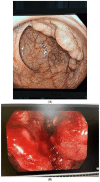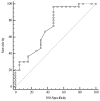Selenium, Zinc, and Plasma Total Antioxidant Status and the Risk of Colorectal Adenoma and Cancer
- PMID: 39330493
- PMCID: PMC11433807
- DOI: 10.3390/metabo14090486
Selenium, Zinc, and Plasma Total Antioxidant Status and the Risk of Colorectal Adenoma and Cancer
Abstract
Selenium (Se), zinc (Zn), and copper (Cu) are known to be involved in carcinogenesis and participate in the defence against reactive oxygen species (ROS). This study aimed to evaluate the clinical utility of serum Se, Zn, and Cu concentrations and plasma total antioxidant status (TAS) in the diagnosis of colorectal cancer (CRC) and colorectal adenoma (CRA) in a population of low Se and borderline Zn status. Based on clinical examination and colonoscopy/histopathology, the patients (n = 79) were divided into three groups: colorectal cancer (n = 30), colorectal adenoma (n = 19), and controls (CONTROL, n = 30). The serum Se concentration was lower in the CRC group than in the CRA group (by 9.1%, p < 0.0001) and the CONTROL group (by 7.9%, p < 0.0001). In turn, the serum Zn concentration was decreased in the CRA group (by 17.9%, p = 0.019) when compared to the CONTROL group. Plasma TAS was lower in the CRC group (by 27.8%, p = 0.017) than in the CONTROL group. In turn, the serum Zn concentration was decreased in the CRA group when compared to the CONTROL group. Plasma TAS was lower in the CRC group than in the CONTROL group. ROC (receiver operating characteristic) curve analysis revealed that the Se level was of the highest diagnostic utility for the discrimination of the CRC group from both the CRA group (area under ROC curve (AUC) 0.958, sensitivity 84.21%, specificity 100%) and the CONTROL group (AUC 0.873, sensitivity 100%, specificity 66.67%). The Zn and TAS levels were significantly accurate in the differentiation between the groups. An individualised risk of colorectal adenoma and cancer approach could comprise Se, Zn, and TAS assays in the population.
Keywords: colorectal adenoma; colorectal cancer; copper; plasma antioxidant status; selenium; zinc.
Conflict of interest statement
The authors declare no conflicts of interest.
Figures








Similar articles
-
Serum levels of zinc, copper, selenium and glutathione peroxidase in the different groups of colorectal cancer patients.Caspian J Intern Med. 2020 Fall;11(4):384-390. doi: 10.22088/cjim.11.4.384. Caspian J Intern Med. 2020. PMID: 33680379 Free PMC article.
-
Concentration of selenium, zinc, copper, Cu/Zn ratio, total antioxidant status and c-reactive protein in the serum of patients with psoriasis treated by narrow-band ultraviolet B phototherapy: A case-control study.J Trace Elem Med Biol. 2017 Dec;44:109-114. doi: 10.1016/j.jtemb.2017.06.008. Epub 2017 Jun 27. J Trace Elem Med Biol. 2017. PMID: 28965564 Clinical Trial.
-
Expression of Selenoprotein Genes and Association with Selenium Status in Colorectal Adenoma and Colorectal Cancer.Nutrients. 2018 Nov 21;10(11):1812. doi: 10.3390/nu10111812. Nutrients. 2018. PMID: 30469315 Free PMC article.
-
Selenium levels in colorectal cancer: A systematic review and meta-analysis of serum, plasma, and colorectal specimens.J Trace Elem Med Biol. 2024 Jul;84:127429. doi: 10.1016/j.jtemb.2024.127429. Epub 2024 Mar 12. J Trace Elem Med Biol. 2024. PMID: 38493666
-
Diagnostic performance of serum metabolites biomarker associated with colorectal adenoma: a systematic review.PeerJ. 2024 Sep 20;12:e18043. doi: 10.7717/peerj.18043. eCollection 2024. PeerJ. 2024. PMID: 39314843 Free PMC article.
References
-
- Globocan 2022 World Health Organization, International Agency for Research on Cancer, Global Cancer Observatory: Cancer Today 2022. 2024. [(accessed on 9 July 2024)]. Available online: https://gco.iarc.who.int/media/globocan/factsheets/populations/900-world....
-
- Ejtehadi F., Taghavi A.R., Fattahi M.R., Shahramian I., Niknam R., Moini M., Tahani M. Prevalence of colonic polyps detected by colonoscopy in symptomatic patients and comparison between different age groups. What age should be considered for investigation? Pol. Przegl. Chir. 2024;96:15–21. doi: 10.5604/01.3001.0053.3997. - DOI - PubMed
Grants and funding
LinkOut - more resources
Full Text Sources

